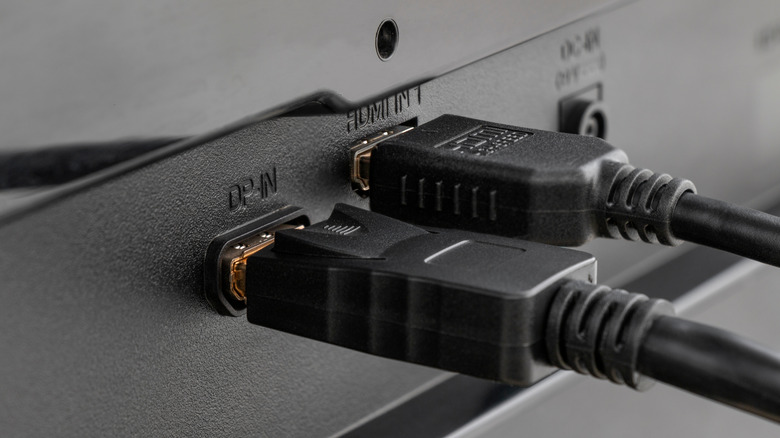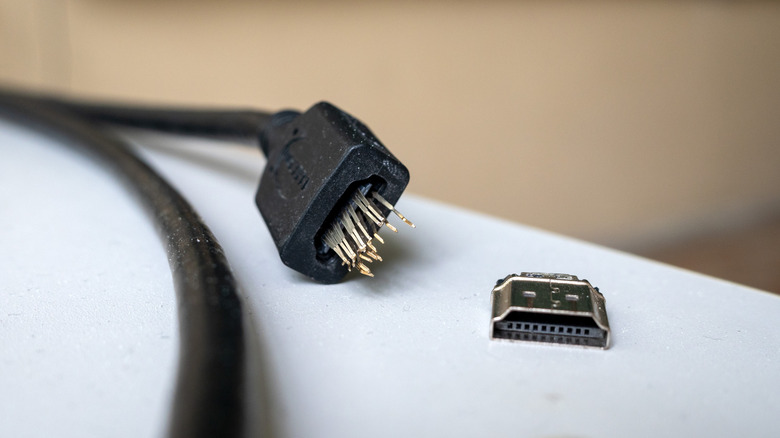5 Reasons You Might Want To Stop Using HDMI Cables
HDMI, which stands for "High-Definition Multimedia Interface," was introduced in 2002, through a collaborative effort by Hitachi, Panasonic, Royal Philips Electronics, Silicon Image, Sony Corporation, Thomson, and Toshiba Corporation, and it's since become the dominant wired standard for transmitting quality video and audio content. The standard facilitates the transmission of uncompressed audiovisual data signals from one source to another. Since its introduction, various versions have been released, and the current one is HDMI 2.1, which can transmit 4K at 120Hz or 8K at 60Hz. HDMI 2.2, capable of handling up to 12K at 120Hz and 16K at 60Hz, was unveiled at CES 2025, but it isn't available yet.
However, owning an HDMI 2.1 cable doesn't necessarily mean you can start viewing 8K content immediately. Both your connected devices must support it, as well as HDMI features such as ARC/eARC, HEC, CEC, HDR, VRR, or ALLM, for optimal performance. You just cannot use any type of HDMI cable and expect smooth and highest quality playback. But with other connection standards such as DisplayPort, USB-C, and Thunderbolt catching up fast, HDMI isn't the best option anymore.
Although HDMI still remains a popular choice because of its ability to transmit audio/video over a single cable and support for a wide range of devices, it isn't perfect. In this guide, we will take a look at several limitations of HDMI and five reasons that you might want to stop using HDMI cables.
Limited cable length
Most of us use HDMI cables to connect devices like gaming consoles, Blu-Ray players, streaming devices, and security cameras to our TVs and monitors. In most cases, regular HDMI cables will be more than sufficient. But if you need to connect devices that are far apart, you need to use a longer HDMI cable. However, most HDMI cables become unreliable at lengths beyond 25 feet. To maintain 4K resolution, the ideal length is around 10 feet. Beyond that, you can start running into degraded visuals, audio lag, sound quality issues, and sometimes total loss of picture.
While you can use specialized HDMI cables made of fiber optics and the ones with built-in signal boosters to solve this issue, better ones are quite expensive and not a good option compared to alternatives. DisplayPort, for instance, uses a packet-based protocol for signal transfer, unlike HDMI, which makes use of transition-minimized differential signaling (TMDS). The benefit? DisplayPort can efficiently transmit higher bandwidth signals over fewer lanes, impacting the length of the cable until signal degradation begins. Active DisplayPort cables are better at handling audiovisual quality over longer distances of 16-32 feet. In fact, a fiber-optic DisplayPort cable can transmit signals over 100 feet.
Serial digital interface (SDI) cables are more common in professional broadcasting setups and video production. The standard can transmit uncompressed audio and video signals over coaxial cables up to a little over 980 feet, with minimal latency and quality degradation, not possible with an HDMI cable.
Lower bandwidth compared to DisplayPort
The most widely adopted version of HDMI – HDMI 2.1 – offers a 48 Gbps maximum bandwidth support, sufficient for most TVs and gaming consoles. The recently introduced HDMI 2.2 raises the bandwidth support to 96 Gbps. In contrast, the current standard DisplayPort 2.1 supports a bandwidth of up to 80 Gbps thoroughly multi-stream transport (MST). DisplayPort also comes with native support for daisy-chaining multiple monitors and higher refresh rates. Additionally, while an HDMI 2.0 supports 4K at 60Hz and HDMI 2.1 supports up to 10K at 60Hz, DP 2.1 supports 16K at 60Hz or 8K at 120Hz.
HDMI's single long architecture makes it unsuitable for multi-monitor setups and ultra-high refresh rate applications. This is why DisplayPort is preferable for competitive gaming, professional content creation, and multi-monitor setups. So, while HDMI excels in consumer electronics with ease of use, broad compatibility, support for Dynamic HDR, eARC, and Variable Refresh Rate (VRR), it cannot provide the professional-grade performance of a DisplayPort without the use of special adapters. In fact, even an HDMI cable as expensive as $1,000 cannot improve audio or video quality.
Additionally, USB-C, rapidly growing in popularity, carries DisplayPort signals via Alt Mode, offering you the same features as native DisplayPort connections. The latest USB 4 and Thunderbolt 4 protocols provide up to 40 Gbps bandwidth with daisy-chaining, making them a suitable choice for modern laptops and portable devices.
Limited multi-monitor capabilities
HDMI is primarily designed for single-monitor use. Meaning each display requires its own dedicated HDMI output for a multi-monitor setup. The result of this would be an utter cable mess. HDMI doesn't support multi-monitor capabilities natively, complicating multi-monitor setups. If you still want to use HDMI for your setup, then you would have to make use of external adapters and splitters. But that isn't the case with DisplayPort. In contrast, DisplayPort natively supports multi-monitor configurations, thanks to multi-stream transport (MST), which enables daisy-chaining several monitors using just one DP. This not only reduces the cable mess but also enhances workspace organization.
DisplayPort is suitable for those in the field of graphic design or developers who extensively use a multi-monitor setup. Gamers also make use of multiple displays for better viewing, where DisplayPort has an edge over HDMI cables. Even high-end VR/AR headsets use the DisplayPort protocol over USB-C to allow for higher refresh rates and resolution. But that's not all. DisplayPorts support higher bandwidths that are better sustained in multi-display setups.
DisplayPort 1.4, which is still widely used even though DisplayPort 2.1 is out there, can handle up to 8K at 60Hz or 4K at 120Hz, making it comparable to HDMI, say HDMI 2.0 or HDMI 2.1. However, DisplayPort has an edge because of its high resolution and refresh rate, 8-bit and 10-bit color support, cross-functionality with USB-C and Thunderbolt 4, and native support for AMD FreeSync and Nvidia G-SYNC, which help reduce screen flickering or stuttering during gaming or graphic-intensive sessions. So, while HDMI can be good for TV and home theatre setups, DisplayPort is ideal for PCs and pro monitors.
Susceptible to interference and degradation
HDMI cables can be made of different materials, but they all lose functionality over time or eventually break. One of their most common issues is their susceptibility to interference, especially over longer distances. Since HDMI cables carry high-bandwidth digital signals, they are sensitive to electromagnetic interference (EMI) and radio frequency interference (RFI), more so when they are made of cheap materials. These kinds of interference can introduce noise in the signal, resulting in image stutter, audio dropouts, sometimes audio or visual loss, or, in some cases, no signal at all.
Environmental factors also play a vital role in the degradation of HDMI cables. Extreme heat, dust, and humidity can damage a cable's insulation and internals. Bending, twisting, or keeping the HDMI cable connected in an awkward position for longer periods can also result in degradation and ultimately in quality loss. If you see any sign of wear and tear, it is time for you to change your HDMI cable.
You can switch over to fiber optic HDMI cables, but they are often more expensive and not very common. SDI cables are generally better compared to HDMI when talking about signal degradation over long distances.
Compatibility issues and ecosystem shift towards USB-C
HDMI is the most popular connectivity medium on a wide range of devices, especially consumer electronics such as TVs, gaming consoles, and home theater systems. HDMI also offers easy connection, support for audio features such as eARC and ARC, and its widespread availability makes it the best choice for connecting devices. However, usage of ports like USB-C is also growing rapidly, and it is slowly becoming the alternative standard of connectivity. Most modern laptops, tablets, and smartphones come with USB-C that supports DisplayPort Alternative Mode (DP Alt Mode), which gives it the power to send or receive high-resolution video and audio signals similar to a DisplayPort.
Additionally, USB-C also allows the user to transfer data at faster speeds to an external drive or a PC and charge connected devices, simultaneously. Another area where USB-C wins over HDMI is its reversible connector. You can connect the cable in any direction, not possible with an HDMI. Furthermore, the latest standards, such as USB4 and Thunderbolt 4, allow for high-speed bandwidths of up to 40 Gbps. While it wouldn't be wrong to say that USB-C may never replace HDMI completely, the all-in-one functionality of USB-C makes it efficient for modern devices as brands are inching closer towards being slimmer and lighter hardware.





